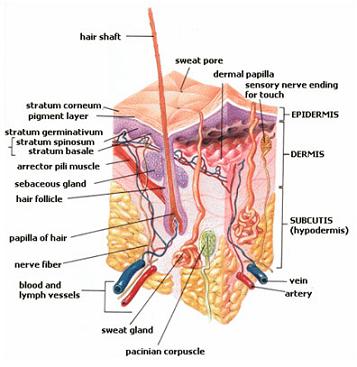[?]Subscribe To This Site
|
Skin: The bare factsArticle submission, Monday 10th September 2007
Easily the largest organ of the entire body the skin is structurally composed of 3 primary layers.

Its primary functions are:
As we know sunlight is important, as from this vitamin D is synthesised, however our greatest enemy is too much exposure to ultra-violet light, of which there are two types. Firstly UVA which causes tanning and is responsible for photo aging (premature aging) which is the damage that occurs after many years of excessive sun exposure, and secondly there is UVB which causes sunburn. Both of which are the main contributors of skin cancers.
So what's the best measure of protection?
Being preventative is always the best course of action which should include:
I would assume that this goes without saying, however skin must be cleaned on a regular basis. Constant peeling of dead cells on the surface mixed with sweat, dirt and or dust if not washed away can become a decomposing breeding ground resulting in bad smells. If this wasn't bad enough it contributes in upsetting the natural ecosystem of micro organic flora which keeps it healthy.
3 basic steps to good skin care
1. Cleansing - firstly avoid bar soaps as they have a tendency to dry out your skin and never use hot or cold water as this can cause broken capillaries. The best way is to use warm water to loosen dirt and unclog pores, then use a small amount of cleanser and apply in a circular motion after which rinse with cool water to close the pores. Keeping in mind that over cleansing is not good either as this can result in `drying your skin' which could create problems.
2. Exfoliate: scrubs work by eliminating unwanted dead cells that dull complexion. This only needs to be initiated once a week but it will really revitalise your skin. Scrubs with `tiny grains' should only be used as opposed to cheaper large grain micro dermabrasions which can tear the epidermal layer.
3. Moisturise: a basic law of good skin care is that everyone, no matter what skin type should moisturise. The only possible exception being those who have acne conditions. Get to know your skin, you'll know best how much to apply. Excessive amounts of moisturiser can become counter-productive and clog pores.

This Healthination video on the nature of skin cancers is highly informative and looks at the pro active approach to protection. Skin disorders Over 150 skin disorders and terms described in detail, along with causes, symptoms and treatment options. An excellent resource from Skin disorders net. A video overview of a revolutionary new skin technology which is entirely 100% preservative free.
Facts sheet of the optimal skin care technology.


|





